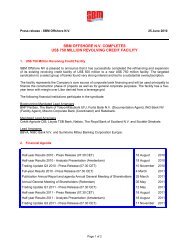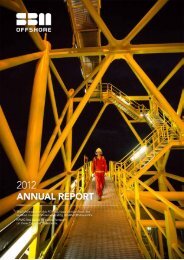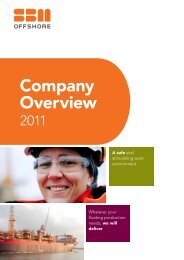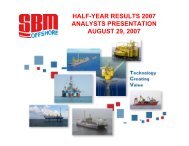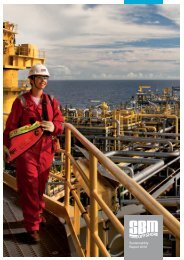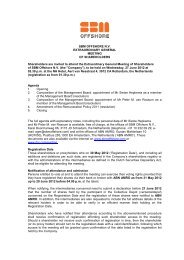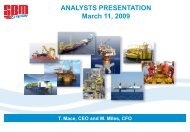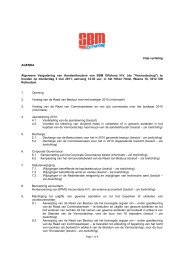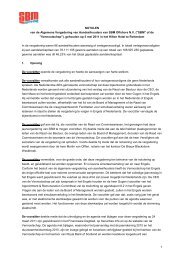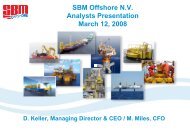1 DRAFT MINUTES of the Annual General Meeting ... - SBM Offshore
1 DRAFT MINUTES of the Annual General Meeting ... - SBM Offshore
1 DRAFT MINUTES of the Annual General Meeting ... - SBM Offshore
Create successful ePaper yourself
Turn your PDF publications into a flip-book with our unique Google optimized e-Paper software.
The second question related to <strong>the</strong> assurance level <strong>of</strong> <strong>the</strong> external accountant’s review in 2010, which was<br />
limited. VBDO asked whe<strong>the</strong>r <strong>the</strong> next level <strong>of</strong> assurance would be reasonable, and whe<strong>the</strong>r <strong>the</strong> Company<br />
would intend to change that level <strong>of</strong> review. Mr Mace replied that <strong>the</strong> Company used <strong>the</strong> sustainability data<br />
to generate trends which it tracks in indicators. The Company considered that <strong>the</strong> external accountant’s<br />
review, at <strong>the</strong> limited level, is adequate for this purpose.<br />
The third question was related to health and safety and <strong>the</strong> HSNS health and safety figures compared to<br />
2009, where it appeared that an important number <strong>of</strong> figures worsened compared to <strong>the</strong> prior year and <strong>the</strong><br />
specific quotation on <strong>the</strong> lost time incident days reported for onshore, <strong>of</strong>fshore and subcontractors. The<br />
question was how <strong>SBM</strong> would explain <strong>the</strong> receded figures and would <strong>SBM</strong> be prepared to make additional<br />
efforts to improve safety for its personnel and suppliers. Mr Mace answered that <strong>the</strong> Company implemented<br />
a more robust reporting system around its operations which, toge<strong>the</strong>r with <strong>the</strong> increase in <strong>the</strong> number <strong>of</strong><br />
safety staff on construction sites, generated a higher reported number <strong>of</strong> incidents. This was <strong>the</strong> reason for<br />
<strong>the</strong> increase in <strong>the</strong> level <strong>of</strong> incidents. The Company placed great importance on <strong>the</strong> safety <strong>of</strong> its employees<br />
and its subcontractors, which was reflected in several initiatives which <strong>the</strong> Company implemented during<br />
<strong>the</strong> last couple <strong>of</strong> years. Some examples were (i) <strong>the</strong> total application <strong>of</strong> safety knowledge and safety<br />
training observation program and (ii) <strong>the</strong> twelve lifesaving rules, which were implemented by <strong>the</strong> Company<br />
worldwide to increase <strong>the</strong> safety and well-being <strong>of</strong> its employees and contractors. Mr Mace mentioned that<br />
<strong>the</strong> Company monitored performance on a continuous basis and implemented additional measures, such as<br />
increased auditing and training, in order to reverse <strong>the</strong> trend. The Company's HSSE performance remained<br />
generally in line with industry benchmarks, however, <strong>the</strong> Company continues to strive to improve in this<br />
area.<br />
The fourth question related to supply chain responsibility. The Company was measured on a VBDO supply<br />
chain management benchmark in which it went down from <strong>the</strong> seventeenth position to <strong>the</strong> nineteenth<br />
position this year. The question was raised whe<strong>the</strong>r <strong>the</strong> Company recognized <strong>the</strong> conclusions drawn by <strong>the</strong><br />
VBDO researchers and if it would take measures to increase supply chain responsibility. Mr Mace replied<br />
that <strong>the</strong> Company received <strong>the</strong> information from <strong>the</strong> VBDO benchmark and conclusions and that <strong>the</strong>se<br />
would be taken into consideration in developing <strong>the</strong> sustainability strategy and initiatives on supply chain.<br />
With <strong>the</strong> current amount <strong>of</strong> reporting initiatives regarding sustainability, <strong>the</strong> Company decided to limit active<br />
participation to <strong>the</strong> Dow Jones sustainability initiative, <strong>the</strong> carbon disclosure project and <strong>the</strong> Ministry <strong>of</strong><br />
Economic Affairs transparency benchmark. As reported in 2010, new indicators regarding value <strong>of</strong> business<br />
with developed and developing countries, as well as information on vendor audits performed, were added.<br />
The Company would intend to continue to develop <strong>the</strong> reporting in this area. It was noted that strong<br />
commitments regarding supply chain were summarised in <strong>the</strong> Company’s Code <strong>of</strong> Conduct.<br />
The fifth question related to <strong>the</strong> Company's operation in Myanmar. In <strong>the</strong> past <strong>the</strong> Company indicated that it<br />
would not extend its contract with Petronas past <strong>the</strong> expiry date and would exit Myanmar. The question was<br />
raised whe<strong>the</strong>r <strong>the</strong> Company is still committed and when <strong>the</strong> contract would expire. Mr Mace replied that<br />
<strong>SBM</strong> is still committed not to extend its existing contract past <strong>the</strong> final expiry date for as long as international<br />
sanctions against Myanmar continue to apply. The current contract runs until May 2015 with an extension<br />
option available to <strong>the</strong> client (Petronas) for up to five years. The final expiry date could be May 2020.<br />
The sixth question related to biodiversity. The industry in which <strong>SBM</strong> operates is known as an industry with<br />
a relatively high impact on biodiversity. In <strong>the</strong> Sustainability Report <strong>SBM</strong> made reference to preservation <strong>of</strong><br />
ecosystems and that it has looked at peers. A remark was made that o<strong>the</strong>r companies do have a more<br />
developed policy on this subject. The VBDO asked whe<strong>the</strong>r <strong>SBM</strong> intends to give biodiversity a more<br />
prominent place in <strong>the</strong> organization and start integrating research on <strong>the</strong> risks and possibilities <strong>of</strong><br />
biodiversity and preservation <strong>of</strong> ecosystems in <strong>the</strong> management <strong>of</strong> <strong>the</strong> business. Mr Mace indicated that <strong>the</strong><br />
7



